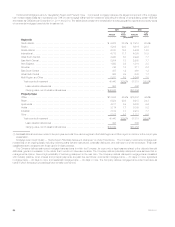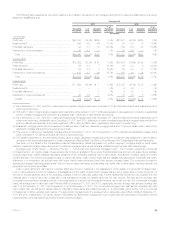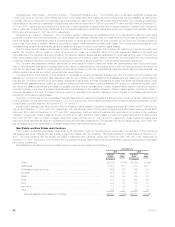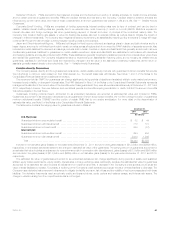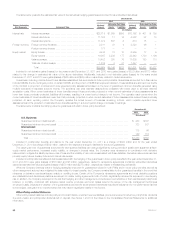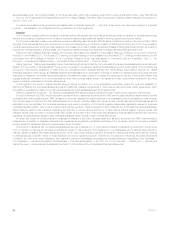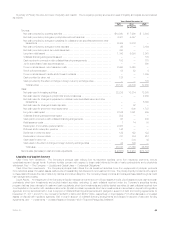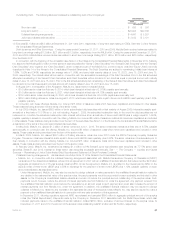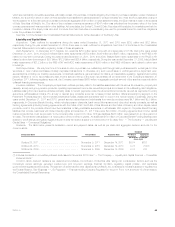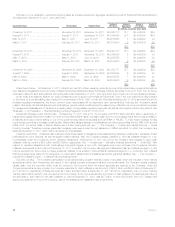MetLife 2011 Annual Report Download - page 68
Download and view the complete annual report
Please find page 68 of the 2011 MetLife annual report below. You can navigate through the pages in the report by either clicking on the pages listed below, or by using the keyword search tool below to find specific information within the annual report.securities based upon the Company’s ability to hold such securities, which may negatively impact the Company’s financial condition. See “Risk Factors
— Some of Our Investments Are Relatively Illiquid and Are in Asset Classes That Have Been Experiencing Significant Market Valuation Fluctuations” in
the 2011 Form 10-K.
In extreme circumstances, all general account assets within a particular legal entity — other than those which may have been pledged to a specific
purpose — are available to fund obligations of the general account of that legal entity.
Capital
The Company’s capital position is managed to maintain its financial strength and credit ratings and is supported by its ability to generate strong cash
flows at the operating companies, borrow funds at competitive rates and raise additional capital to meet its operating and growth needs.
The Company was able to issue new debt and remarket outstanding debt during the difficult market conditions prevailing in the second half of 2008
and early 2009, as well as during the rebound and recovery periods beginning in the second quarter of 2009 and continuing into 2010. The increase in
credit spreads experienced during the crisis resulted in an increase in the cost of capital, as well as increases in facility fees. Most recently, as a result of
reductions in interest rates and credit spreads, the Company’s interest expense and dividends on floating rate securities have been lower.
Despite the still unsettled financial markets, the Company also raised new capital from successful offerings of MetLife, Inc.’s common stock in
August 2010 and March 2011. The August 2010 offering provided financing for the Acquisition and the March 2011 offering provided financing for the
repurchase from AM Holdings of MetLife, Inc.’s Convertible Preferred Stock that was issued in connection with the Acquisition. See “— The
Company — Liquidity and Capital Sources — Convertible Preferred Stock” and “— Common Stock.”
Rating Agencies. Rating agencies assign insurer financial strength ratings to MetLife, Inc.’s domestic life insurance subsidiaries and credit ratings to
MetLife, Inc. and certain of its subsidiaries. The level and composition of regulatory capital at the subsidiary level and equity capital of the Company are
among the many factors considered in determining the Company’s insurer financial strength and credit ratings. Each agency has its own capital
adequacy evaluation methodology, and assessments are generally based on a combination of factors. In addition to heightening the level of scrutiny that
they apply to insurance companies, rating agencies have increased and may continue to increase the frequency and scope of their credit reviews, may
request additional information from the companies that they rate and may adjust upward the capital and other requirements employed in the rating
agency models for maintenance of certain ratings levels.
A downgrade in the credit or insurer financial strength ratings of MetLife, Inc. or its subsidiaries would likely impact the cost and availability of
financing for MetLife, Inc. and its subsidiaries and result in additional collateral requirements or other required payments under certain agreements, which
are eligible to be satisfied in cash or by posting securities held by the subsidiaries subject to the agreements.
Statutory Capital and Dividends. Our insurance subsidiaries have statutory surplus well above levels to meet current regulatory requirements.
Except for American Life, RBC requirements are used as minimum capital requirements by the NAIC and the state insurance departments to identify
companies that merit regulatory action. RBC is based on a formula calculated by applying factors to various asset, premium and statutory reserve items.
The formula takes into account the risk characteristics of the insurer, including asset risk, insurance risk, interest rate risk and business risk andis
calculated on an annual basis. The formula is used as an early warning regulatory tool to identify possible inadequately capitalized insurers for purposes
of initiating regulatory action, and not as a means to rank insurers generally. These rules apply to each of MetLife, Inc.’s domestic insurance subsidiaries.
State insurance laws provide insurance regulators the authority to require various actions by, or take various actions against, insurers whose total
adjusted capital does not meet or exceed certain RBC levels. At the date of the most recent annual statutory financial statements filed with insurance
regulators, the total adjusted capital of each of these subsidiaries was in excess of each of those RBC levels.
American Life does not conduct insurance business in Delaware or any other domestic state and, as such, is exempt from RBC requirements by
Delaware law. In addition to Delaware, American Life operations are regulated by applicable authorities of the countries in which the company operates
and are subject to capital and solvency requirements in those countries.
The amount of dividends that our insurance subsidiaries can pay to MetLife, Inc. or other parent entities is constrained by the amount of surplus we
hold to maintain our ratings and provides an additional margin for risk protection and investment in our businesses. We proactively take actions to
maintain capital consistent with these ratings objectives, which may include adjusting dividend amounts and deploying financial resources from internal
or external sources of capital. Certain of these activities may require regulatory approval. Furthermore, the payment of dividends and other distributions
to MetLife, Inc. and other parent entities by their respective insurance subsidiaries is regulated by insurance laws and regulations. See “Business —
U.S. Regulation — Insurance Regulation” and “Business — International Regulation” in the 2011 Form 10-K. See also “— MetLife, Inc. — Liquidity and
Capital Sources — Dividends from Subsidiaries” and Note 18 of the Notes to the Consolidated Financial Statements.”
64 MetLife, Inc.


